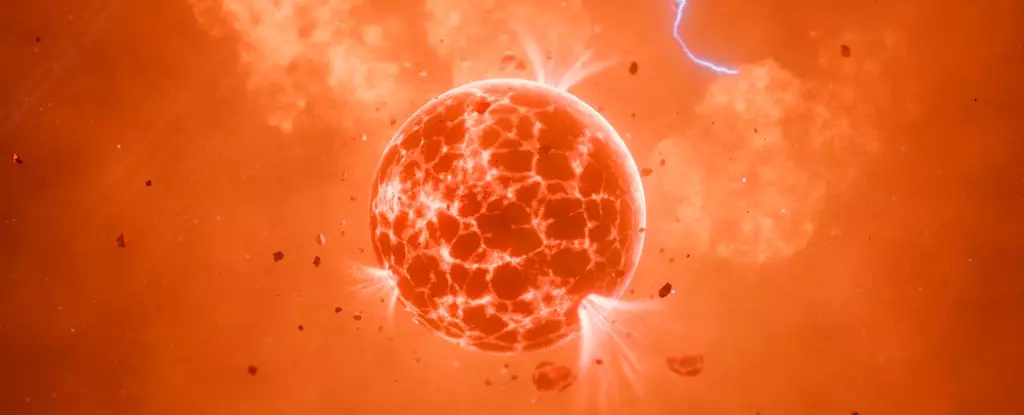The ever-expanding frontiers of astronomy have continuously captivated researchers and enthusiasts alike, particularly with the discovery of exoplanets and their complexities. Among these celestial wonders lies the intriguing case of WASP-49b, an exoplanet uniquely positioned around a yellow dwarf star, WASP-49, approximately 635 light-years away from Earth. Recent observations indicate that this gas giant may be accompanied by a volcanic exomoon, providing researchers with critical insights into the dynamics of exoplanetary systems.
What makes the WASP-49b system particularly fascinating is a massive cloud of neutral sodium detected in its vicinity. This phenomenon has raised compelling questions about its origin. Since WASP-49b is a gas giant, it is improbable that it possesses volcanic activity akin to smaller, rocky planets. According to astrophysicist Apurva Oza from the California Institute of Technology, the sodium cloud’s behavior defies expectations; it appears to orbit in a way that suggests a different source—likely a nearby exomoon. The sodium cloud’s unexpected trajectory presents an argument that, if validated, would enrich our understanding of celestial bodies beyond our solar system.
Despite the excitement surrounding this discovery, the journey to identify exomoons presents numerous challenges. While our Solar System boasts nearly 300 known moons—far exceeding the number of planets—detecting exomoons remains an arduous endeavor. The minuscule nature of signals produced by these moons can easily be overshadowed by other astrophysical phenomena, complicating their identification. Consequently, astronomers often encounter cases where unusual signals are misunderstood or misattributed to alternate celestial mechanisms, rendering the task of exomoon detection even more daunting.
At present, researchers are undergoing a concerted effort to refine their methodologies, enhancing the likelihood of uncovering these elusive bodies. Among these endeavors, the WASP-49b system offers a promising opportunity due to its atypical sodium cloud, first noted in 2017 when analyses revealed this unexpected layer surrounding the gas giant. The 2019 research led by Oza and his team meticulously laid out their hypothesis that the observed sodium could be attributed to an orbiting volcanic exomoon, reminiscent of Jupiter’s highly active moon, Io.
Known for their unique features that often suggest volcanic activity, rocky exoplanets can exhibit a variety of signs, such as extreme temperature profiles or eccentric orbits. In stark contrast, gas giants like WASP-49b are not typically associated with volcanic phenomena. However, the ongoing intrigue surrounding the sodium cloud necessitates a careful evaluation of potential sources.
The challenge lies in understanding the behavior of the sodium cloud detected around WASP-49b. It appears irregularly, vanishing behind both the exoplanet and the host star intermittently. This sporadic appearance strongly suggests a non-permanent nature, aligning more closely with an external body, like a volcanic exomoon, rather than the gas giant itself. Given the properties of neutral sodium, which can ionize quickly when exposed to stellar radiation, the detection of neutral sodium reinforces the hypothesis that its production must be consistent and ongoing, likely stemming from an exomoon’s volcanic activity.
To further investigate this hypothesis, researchers employed advanced computer models to simulate the system’s dynamics. Findings propose that the exomoon could orbit WASP-49b approximately every eight hours, subjecting it to significant gravitational forces. This gravitational interplay could drive volcanic processes similar to those seen on Io, which experiences intense tidal forces from Jupiter and its other moons. These forces may contribute to the moon’s volcanic vigor, highlighting how gravitational interactions shape the fates of celestial bodies across the cosmos.
However, there lies a potential consequence to this forcible dance in the universe: the exomoon’s orbit may gradually decay as volcanic activity continues to erode its mass. If this exomoon does indeed exist, it could face a dramatic demise, spiraling into WASP-49b due to its unstable orbit and shifting masses.
The ongoing investigation of WASP-49b and its intriguing sodium cloud represents a pivotal moment in exoplanetary science, challenging existing conceptions of celestial dynamics. As researchers peel back the layers surrounding this potential volcanic exomoon, they inch closer to understanding the wide array of planetary systems and their components. The quest for knowledge about exomoons not only changes our perception of volcanism beyond Earth but also offers hope for future explorations into the mysteries of our universe’s formation and evolution. In this search for extraterrestrial bodies, the cosmos never ceases to amaze, pushing the boundaries of what we know and igniting our imagination for what remains undiscovered.


Leave a Reply